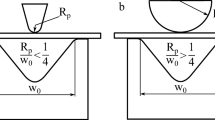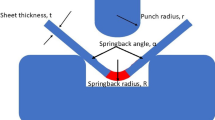Abstract
Air-bending is a major sheet-metal forming operation, where precise prediction of the developed shape is a key factor for the accuracy assessment of the final shape for the part after bending. To predict the blank shape, accurate estimation of the bend-allowance (BA) is necessary, which can be defined as the length of the un-stretched fiber at the bent state of shape. There are several different approaches to find the BA values depending on either experience-based or knowledge-based techniques. In this paper, a brief summary is provided for different approaches to find the BA values by comparing their advantages as well as, their drawbacks. They are evaluated in terms of accuracy, efficiency and ease of implementation for integrated CAD/CAM environment. Then, a novel approach; by using higher order response surface (RS) fitting for the prediction of BA during air-bending is demonstrated. This technique is in general found very promising as an integrated tool for both CAD interfaces, as well as CNC machine tools. The RS predictions, which are generated from over 1,000 bending experiments using combinations of bending radius, bending angle and material thickness, are built for different orders and are compared to Artificial Neural Network (ANN) models that are also trained by using the same experimental data.
Similar content being viewed by others
References
Suchy I (1997) Handbook of die design, McGraw-Hill, New York
Forcellese A, Gabrielli F, Ruffini R (1998) Effect of the training set size on springback control by neural network in an air bending process. J Mater Process Technol 80–81:493–500
Inamdar M, Date PP, Desai UB (2000) Studies on the prediction of springback in air vee bending of metallic sheets using an artificial neural network. J Mater Process Technol 108:45–54
Elkins KL, Sturges RH (2001) Design of a sensor for on-line measurement of loaded bend angle for pressbrake control. Robot Comput-Integr Manuf 17:329–340
Livatyali H, Kinzel GL, Altan T (2003) Computer aided die design of straight flanging using approximate numerical analysis. J Mater Process Technol 142:532–543
Wang C, Kinzel G, Altan T (1993) Mathematical modeling of plane-strain bending of sheet and plate. J Mater Process Technol 39:279–304
Prasad YKDV, Somasundaram S (1993) A mathematical model for bend-allowance calculation in automated sheet-metal bending. J Mater Process Technol 39:337–356
Heller B, Kleiner M (2006) Semi-analytical process modeling and simulation of air bending. J Strain Anal Eng Des 41:57–80
Vin de JL, Streppel AH, Singh UP, Kals HJJ (1996) A process model for air bending. J Mater Process Technol 57:48–54
Anokye-Siribor K, Singh UP (2000) A new analytical model for pressbrake forming using in-process identification of material characteristics. J Mater Process Technol 99:103–112
Streppel AH, Lutters D, Brinke ET, Pijlman HH, Kals HJJ (2001) Process modeling for air bending: validation by experiments and simulations. J Mater Process Technol 115:76–82
Antonelli L, Salvini P, Vivio F, Vullo V (2007) Identification of elasto-plastic characteristics by means of air-bending test. J Mater Process Technol 183:127–139
Fei D, Hodgson P (2006) Experimental and numerical studies of springback in air v-bending process for cold rolled TRIP steels. Nucl Eng Des 236:1847–1851
Bruni C, Forcellese A, Gabrielli F, Simoncini M (2006) Air bending of AZ31 magnesium alloy in warm and hot forming conditions. J Mater Process Technol 177:373–376
Singh UP, Maiti SK, Date PP, Narasimhan K (2004) Numerical simulation of the influence of air bending tool geometry on product quality. J Mater Process Technol 145:269–275
De Vin LJ (2001) Expecting the unexpected, a must for accurate brakeforming. J Mater Process Technol 117:244–248
De Vin LJ (2000) Curvature prediction in air bending of metal sheet: J Mater Process Technol 100:257–261
Bremberger M (1965) Stanzerei Handbuch. Hanser, München
DIN 6935 standard (1969) Supplementary sheet 1–2, cold forming by press brake and cold bending of flat rolled steel - cold forming and cold bending of flat rolled steel products calculated compensating values for different bending angles
Ozcelik B, Buyuk M (2001) An experimental approach for determining the bend allowance in air-bending process: 2nd Int Conference on Design and Production of Dies and Molds, Kuşadası, TURKEY, 21-23 June 2001
Duflou JR, Vancza J, Aerens R (2005) Computer aided process planning for sheet metal bending: a state of the art. Comput Ind 56:747–771
Choi JC, Kim BM, Kim C (1999) An automated progressive process planning and die design and working system for blanking or piercing and bending of a sheet metal product. Int J Adv Manufac Technol 15:485–497
Matlab User Manual (2002) Version 6.5 Release 13, The MathWorks, Inc
Box GEP, Draper NR (1987) Empirical model-building and response surface. Wiley, New York
Stander N, Roux WJ, Eggleston T, Craig KJ (2006) LS-OPT version 3.1 user’s manual. Livermore Software Technology Corporation, CA, USA
Oktem H, Erzurumlu T, Kurtaran H (2005) Application of response surface methodology in the optimization of cutting conditions for surface roughness. J Mater Process Technol 170(1–2):11–16
Kurtaran H, Erzurumlu T (2006) Efficient warpage optimization of thin shell plastic parts using response surface methodology and genetic algorithm. Int J Adv Manufac Technol 27(5–6):468–472
Author information
Authors and Affiliations
Corresponding author
Rights and permissions
About this article
Cite this article
Kurtaran, H. A novel approach for the prediction of bend allowance in air bending and comparison with other methods. Int J Adv Manuf Technol 37, 486–495 (2008). https://doi.org/10.1007/s00170-007-0987-y
Received:
Accepted:
Published:
Issue Date:
DOI: https://doi.org/10.1007/s00170-007-0987-y




